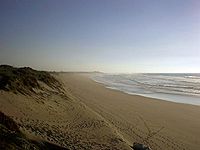
Rio Alto
Encyclopedia

Rio Alto Beach
Rio Alto Beach is a beach situated near the city Póvoa de Varzim in the northern parish of Estela, in northern Portugal, 35 km north of Oporto...
. The shoreline of Estela is also known as Rio Alto.
The Rio Alto minute estuary area is known for its wide sand dunes and has become a tourist destination. One of the local facilities is the Camping Park of Rio Alto, which is surrounded by a forest of pine trees planted by the Monks of Tibães
Monastery of Tibães
The Monastery of St Martin of Tibães is a monastery situated in the parish of Mire de Tibães, near Braga, in northern Portugal. It was the mother house of the Benedictine order in Portugal and Brazil, and it is known for the exuberant Rococo decoration of its church.-History:The first information...
in the 18th Century and the peculiar masseira
Masseira
Masseira is a unique form of traditional farming technique practised in the parishes of Estela and Aguçadoura in the north of Póvoa de Varzim in Portugal, and in the neighbouring parish of Apúlia in Esposende...
s farm fields, which were also made by these monks.
Nearby are the Estela Golf Club, and the naturist beach area of Rio Alto. To the north, one can find the ruins of the Roman villa
Roman villa
A Roman villa is a villa that was built or lived in during the Roman republic and the Roman Empire. A villa was originally a Roman country house built for the upper class...
known as Villa Mendo, which was abandoned in the beginning of the early years of Portugal.
In 1908, two local individuals, knowing that ancient artifacts were sometimes found in the area, decided to investigate the place and discovered jewels, gold and silver. They decided to take the jewels to a silversmith. The silversmith, verifying the value and antiquity of the artifacts, decided to speak with Rocha Peixoto, an archaeologist who was in Póvoa de Varzim. Rocha Peixoto and José Fortes interrogated the finders on the location of the findings. Some time later, José Fortes published an article in the Portugália stating that these jewels were of the Castro culture
Castro culture
Castro culture is the archaeological term for naming the Celtic archaeological culture of the northwestern regions of the Iberian Peninsula from the end of the Bronze Age until it was subsumed in local Roman culture...
. Several people tried to find the town that was probably below the sand dunes, but without success and only a few minor findings were discovered. Locals were known to keep secret what they found. In June 1992, while removing sands, a bulldozer driver found a wall and ceramics, thus discovering the lost Roman villa.
External links
- Portugal Virtual Golf Estela
- Estela Golf Club
- Orbitur Rio Alto - Camping Park

